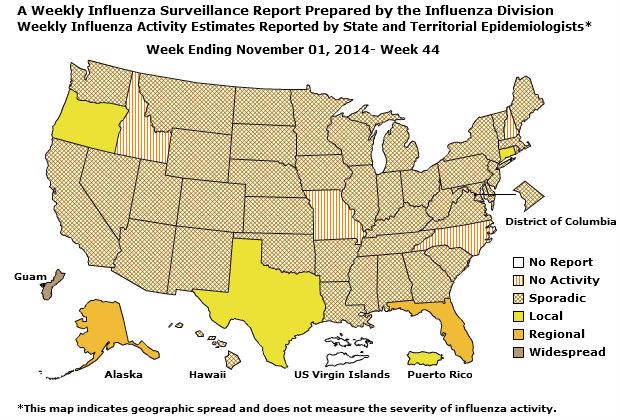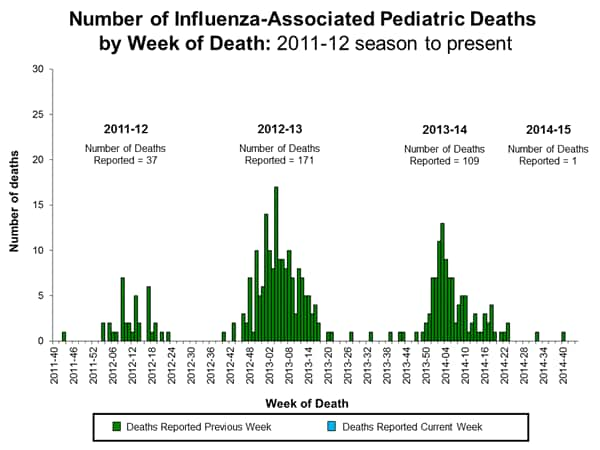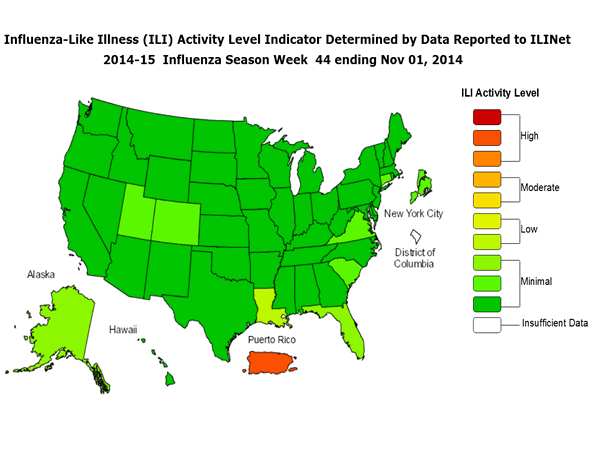
2014-2015 Influenza Season Week 44 ending November 1, 2014
All data are preliminary and may change as more reports are received.
Synopsis:
During week 44 (October 26 – November 1, 2014), influenza activity was low in the United States.
- Viral Surveillance: Of 8,439 specimens tested and reported by U.S. World Health Organization (WHO) and National Respiratory and Enteric Virus Surveillance System (NREVSS) collaborating laboratories during week 44, 504 (6.0%) were positive for influenza.
- Pneumonia and Influenza Mortality: The proportion of deaths attributed to pneumonia and influenza (P&I) was below the epidemic threshold.
- Influenza-associated Pediatric Deaths: No influenza-associated pediatric deaths were reported.
- Outpatient Illness Surveillance: The proportion of outpatient visits for influenza-like illness (ILI) was 1.5%, which is below the national baseline of 2.0%. All 10 regions reported ILI below region-specific baseline levels. Puerto Rico experienced high ILI activity; one state experienced low ILI activity; New York City and 49 states experienced minimal ILI activity; and the District of Columbia had insufficient data.
- Geographic Spread of Influenza: The geographic spread of influenza in Guam was reported as widespread; two states reported regional activity; Puerto Rico and three states reported local activity; the District of Columbia and 40 states reported sporadic activity; five states reported no influenza activity; and the U.S. Virgin Islands did not report.
| HHS Surveillance Regions* | Data cumulative since September 28, 2014 (week 40) | |||||||
|---|---|---|---|---|---|---|---|---|
| Out-patient ILI† | % positive for flu‡ | Number of jurisdictions reporting regional or widespread activity§ | 2009 H1N1 | A (H3) | A(Subtyping not performed) | B | Pediatric Deaths | |
| Nation | Normal | 6.0% | 3 of 54 | 20 | 702 | 890 | 645 | 1 |
| Region 1 | Normal | 1.2% | 0 of 6 | 1 | 12 | 12 | 8 | 0 |
| Region 2 | Normal | 1.7% | 0 of 4 | 4 | 66 | 6 | 20 | 0 |
| Region 3 | Normal | 3.6% | 0 of 6 | 0 | 36 | 25 | 24 | 0 |
| Region 4 | Normal | 9.3% | 1 of 8 | 1 | 133 | 581 | 379 | 1 |
| Region 5 | Normal | 3.2% | 0 of 6 | 8 | 64 | 36 | 31 | 0 |
| Region 6 | Normal | 7.0% | 0 of 5 | 2 | 105 | 127 | 114 | 0 |
| Region 7 | Normal | 2.6% | 0 of 4 | 0 | 30 | 16 | 20 | 0 |
| Region 8 | Normal | 2.0% | 0 of 6 | 0 | 26 | 23 | 13 | 0 |
| Region 9 | Normal | 4.2% | 1 of 5 | 4 | 84 | 47 | 28 | 0 |
| Region 10 | Normal | 9.0% | 1 of 4 | 0 | 146 | 17 | 8 | 0 |
*HHS regions (Region 1 CT, ME, MA, NH, RI, VT; Region 2: NJ, NY, Puerto Rico, US Virgin Islands; Region 3: DE, DC, MD, PA, VA, WV; Region 4: AL, FL, GA, KY, MS, NC, SC, TN; Region 5: IL, IN, MI, MN, OH, WI; Region 6: AR, LA, NM, OK, TX; Region 7: IA, KS, MO, NE; Region 8: CO, MT, ND, SD, UT, WY; Region 9: AZ, CA, Guam, HI, NV; and Region 10: AK, ID, OR, WA).
† Elevated means the % of visits for ILI is at or above the national or region-specific baseline
‡ National data are for current week; regional data are for the most recent three weeks
§ Includes all 50 states, the District of Columbia, Guam, Puerto Rico, and U.S. Virgin Islands
U.S. Virologic Surveillance:
WHO and NREVSS collaborating laboratories located in all 50 states, Puerto Rico, and the District of Columbia report to CDC the number of respiratory specimens tested for influenza and the number positive by influenza virus type and influenza A virus subtype. The results of tests performed during the current week are summarized in the table below. Region specific data are available at http://gis.cdc.gov/grasp/fluview/fluportaldashboard.html.
| Week 44 | |
|---|---|
| No. of specimens tested | 8,439 |
| No. of positive specimens (%) | 504 (6.0%) |
| Positive specimens by type/subtype | |
| Influenza A | 394 (78.2%) |
| 2009 H1N1 | 1 (0.2%) |
| H3 | 120 (30.5%) |
| Subytping not performed | 273 (69.3%) |
| Influenza B | 110 (21.8%) |
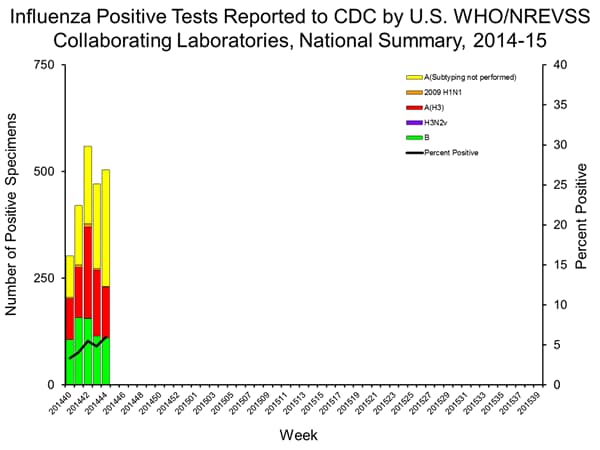
View National and Regional Level Graphs and Data | View Chart Data | View Full Screen | View PowerPoint Presentation
Antigenic Characterization:
CDC has antigenically characterized 10 influenza A (H3N2) viruses collected by U.S. laboratories since October 1, 2014 by hemagglutination inhibition (HI).
Influenza A (H3N2) [10]:
- Seven (70%) of the 10 influenza A (H3N2) viruses tested have been characterized as A/Texas/50/2012-like, the influenza A (H3N2) component of the 2014-2015 Northern Hemisphere influenza vaccine. Three (30%) viruses showed reduced titers with antiserum raised against A/Texas/50/2012 but were antigenically similar to A/Switzerland/9715293/2013, the H3N2 virus selected for the 2015 Southern Hemisphere influenza vaccine. A/Switzerland/9715293/2013 is related to, but antigenically and genetically distinguishable from the A/Texas/50/2012 vaccine virus. A/Switzerland-like H3N2 viruses were first detected in the United States in small numbers in March of 2014 and began to circulate in greater numbers over the spring and summer.
CDC previously reported that 49% of H3N2 viruses collected worldwide from May 18-September 20, 2014 were antigenically similar to A/Texas/50/2012 ("Update: Influenza Activity – United States and Worldwide, May 18-September 20, 2013" in the MMWR) and 42% of viruses collected in the United States during that time were antigenically similar to A/Texas/50/2012 (FluView Week 40). CDC conducts antigenic characterization of influenza viruses year-round to compare how similar currently circulating influenza viruses are to those included in the influenza vaccine, and to monitor for changes in circulating influenza viruses.
Antiviral Resistance:
Testing of 2009 H1N1, influenza A (H3N2), and influenza B virus isolates for resistance to neuraminidase inhibitors (oseltamivir and zanamivir) is performed at CDC using a functional assay. Additional 2009 H1N1 and influenza A (H3N2) clinical samples are tested for mutations of the virus known to confer oseltamivir resistance. The data summarized below combine the results of both testing methods. These samples are routinely obtained for surveillance purposes rather than for diagnostic testing of patients suspected to be infected with antiviral-resistant virus.
High levels of resistance to the adamantanes (amantadine and rimantadine) persist among 2009 influenza A (H1N1) and A (H3N2) viruses (the adamantanes are not effective against influenza B viruses). Therefore, data from adamantane resistance testing are not presented below.
| Oseltamivir | Zanamivir | |||
|---|---|---|---|---|
| Virus Samples tested (n) | Resistant Viruses, Number (%) | Virus Samples tested (n) | Resistant Viruses, Number (%) | |
| Influenza A (H3N2) | 6 | 0 (0.0) | 6 | 0 (0.0) |
| Influenza B | 0 | 0 (0.0) | 0 | 0 (0.0) |
| 2009 H1N1 | 0 | 0 (0.0) | 0 | 0 (0.0) |
The majority of recently circulating influenza viruses have been susceptible to the neuraminidase inhibitor antiviral medications, oseltamivir and zanamivir; however, rare sporadic instances of oseltamivir-resistant 2009 H1N1 and A (H3N2) viruses have been detected worldwide. Antiviral treatment with oseltamivir or zanamivir is recommended as early as possible for patients with confirmed or suspected influenza who have severe, complicated, or progressive illness; who require hospitalization; or who are at high risk for serious influenza-related complications. Additional information on recommendations for treatment and chemoprophylaxis of influenza virus infection with antiviral agents is available at http://www.cdc.gov/flu/antivirals/index.htm.
Pneumonia and Influenza (P&I) Mortality Surveillance:
During week 44, 5.7% of all deaths reported through the 122 Cities Mortality Reporting System were due to P&I. This percentage was below the epidemic threshold of 6.2% for week 44.
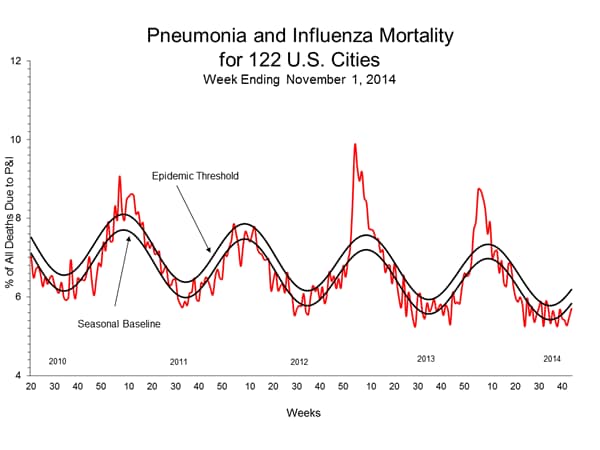
View Full Screen | View PowerPoint Presentation
Influenza-Associated Pediatric Mortality:
No influenza-associated pediatric deaths were reported to CDC during week 44. To date, one influenza-associated pediatric death has been reported for the 2014-2015 season.
Additional data can be found at: http://gis.cdc.gov/GRASP/Fluview/PedFluDeath.html.
Influenza-Associated Hospitalizations:
The Influenza Hospitalization Surveillance Network (FluSurv-NET) conducts all age population-based surveillance for laboratory-confirmed influenza-related hospitalizations in select counties in the Emerging Infections Program (EIP) states and Influenza Hospitalization Surveillance Project (IHSP) states. FluSurv-NET estimated hospitalization rates will be updated weekly starting later this season. Additional FluSurv-NET data can be found at: http://gis.cdc.gov/GRASP/Fluview/FluHospRates.html and http://gis.cdc.gov/grasp/fluview/FluHospChars.html.
Outpatient Illness Surveillance:
Nationwide during week 44, 1.5% of patient visits reported through the U.S. Outpatient Influenza-like Illness Surveillance Network (ILINet) were due to influenza-like illness (ILI). This percentage is below the national baseline of 2.0%.
(ILI is defined as fever (temperature of 100°F [37.8°C] or greater) and cough and/or sore throat.)
Additional data are available at http://gis.cdc.gov/grasp/fluview/fluportaldashboard.html.
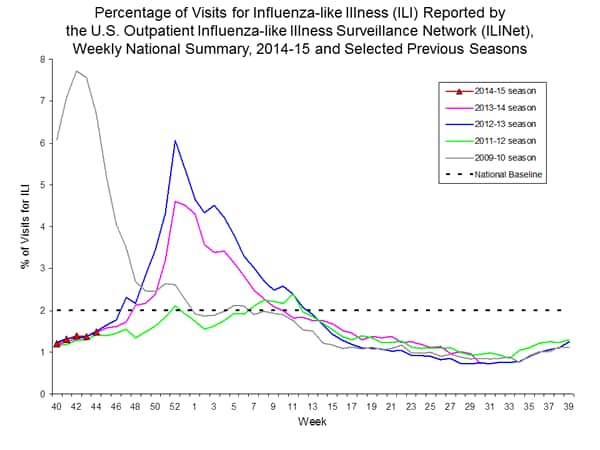
View National and Regional Level Graphs and Data | View Chart Data | View Full Screen | View PowerPoint Presentation
On a regional level, the percentage of outpatient visits for ILI ranged from 0.8% to 2.3% during week 44. All 10 regions reported a proportion of outpatient visits for ILI below their region-specific baseline levels.
ILINet State Activity Indicator Map:
Data collected in ILINet are used to produce a measure of ILI activity* by state. Activity levels are based on the percent of outpatient visits in a state due to ILI and are compared to the average percent of ILI visits that occur during weeks with little or no influenza virus circulation. Activity levels range from minimal, which would correspond to ILI activity from outpatient clinics being below, or only slightly above, the average, to high, which would correspond to ILI activity from outpatient clinics being much higher than average.
During week 44, the following ILI activity levels were experienced:
- Puerto Rico experienced high ILI activity.
- One state (Louisiana) experienced low ILI activity.
- New York City and 49 states (Alabama, Alaska, Arizona, Arkansas, California, Colorado, Connecticut, Delaware, Florida, Georgia, Hawaii, Idaho, Illinois, Indiana, Iowa, Kansas, Kentucky, Maine, Maryland, Massachusetts, Michigan, Minnesota, Mississippi, Missouri, Montana, Nebraska, Nevada, New Hampshire, New Jersey, New Mexico, New York, North Carolina, North Dakota, Ohio, Oklahoma, Oregon, Pennsylvania, Rhode Island, South Carolina, South Dakota, Tennessee, Texas, Utah, Vermont, Virginia, Washington, West Virginia, Wisconsin, and Wyoming) experienced minimal ILI activity.
- Data were insufficient to calculate an ILI activity level from the District of Columbia.
*This map uses the proportion of outpatient visits to health care providers for influenza-like illness to measure the ILI activity level within a state. It does not, however, measure the extent of geographic spread of flu within a state. Therefore, outbreaks occurring in a single city could cause the state to display high activity levels.
Data collected in ILINet may disproportionally represent certain populations within a state, and therefore, may not accurately depict the full picture of influenza activity for the whole state.
Data displayed in this map are based on data collected in ILINet, whereas the State and Territorial flu activity map is based on reports from state and territorial epidemiologists. The data presented in this map is preliminary and may change as more data is received.
Differences in the data presented here by CDC and independently by some state health departments likely represent differing levels of data completeness with data presented by the state likely being the more complete.
Geographic Spread of Influenza as Assessed by State and Territorial Epidemiologists
The influenza activity reported by state and territorial epidemiologists indicates geographic spread of influenza viruses, but does not measure the severity of influenza activity.
During week 44, the following influenza activity was reported:
- Widespread influenza activity was reported by Guam.
- Regional influenza activity was reported by two states (Alaska and Florida).
- Local influenza activity was reported by Puerto Rico and three states (Connecticut, Oregon, and Texas).
- Sporadic influenza activity was reported by the District of Columbia and 40 states (Alabama, Arizona, Arkansas, California, Colorado, Delaware, Georgia, Hawaii, Illinois, Indiana, Iowa, Kansas, Kentucky, Louisiana, Maine, Maryland, Massachusetts, Michigan, Minnesota, Mississippi, Montana, Nebraska, Nevada, New Jersey, New Mexico, New York, North Dakota, Ohio, Oklahoma, Pennsylvania, South Carolina, South Dakota, Tennessee, Utah, Vermont, Virginia, Washington, West Virginia, Wisconsin, and Wyoming).
- No influenza activity was reported by five states (Idaho, Missouri, New Hampshire, North Carolina, and Rhode Island).
- The U.S. Virgin Islands did not report.
